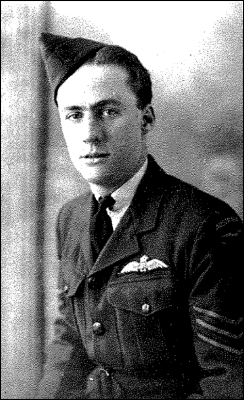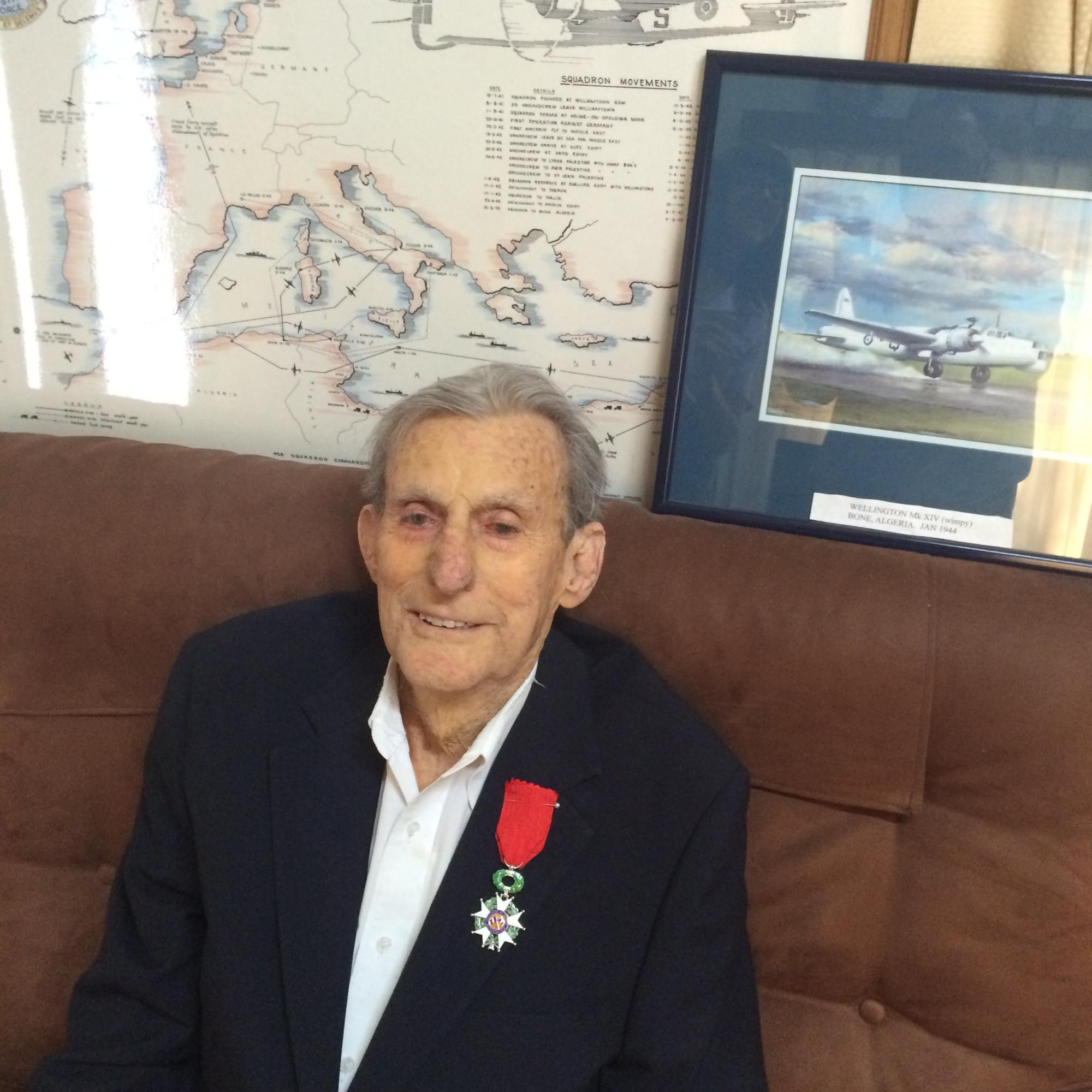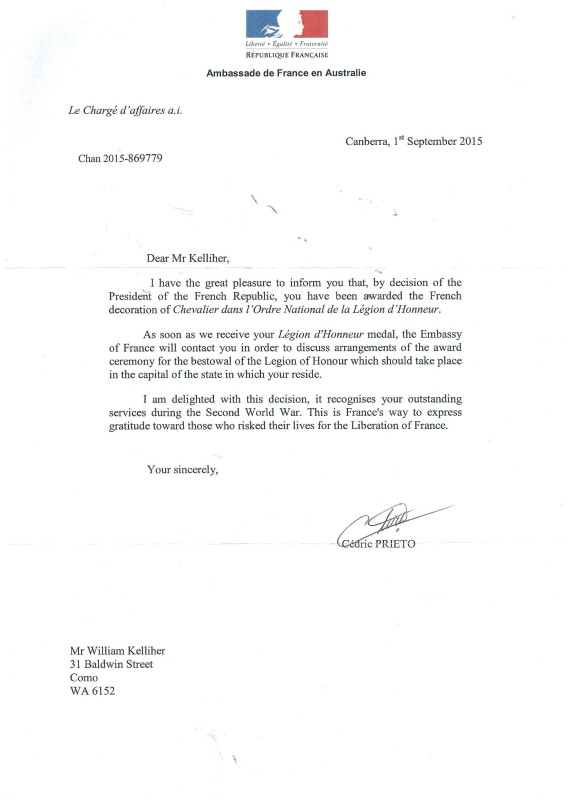WARRANT OFFICER WILLIAM 'BILL' KELLIHER SERVICE NUMBER 406720
Bill was born in Narrogin on 4 June 1921, and grew up on the newly established family farm Bonievale, near Toolibin in the wheatbelt Bill drove a horse and buggy to Noman’s Lake Primary School with his elder brother Noel and his two sisters Denise and Nancy. This method of conveyance confirmed his idea that horses required more food intake than the energy they provided, and he was very pleased that his father sold all the horses when his Blacksmith Shop became the first Ford motor car dealer in Narrogin, and the first rubber tyred tractors replaced horses for the farm work.
In 1934 Bill went to Narrogin High School with his brother Noel, and the next year the two boys were sent to board at Christian Brothers College in St Georges Terrace. A plaque remains in the footpath where the College was at that time, now the Duxton Hotel. In 1936, Aquinas was set up at Mount Henry, and the all the boys were sent up there to plant trees and clear the oval. It was slave labour according to Bill!
At the end of 1938 Bill did his Leaving Certificate, and went back home to the farm for that Christmas. He had applied for a place at an RAF training school, but received a letter saying that due to the outbreak of hostilities, the school had closed. He then spent 1939, somewhat uncomfortably, at the farm, but in March 1941 he enlisted in the Royal Australian Air Force at Pearce Airbase.
After initial training in the most important aspects of the Airforce in wartime, like marching in unison on parade, the selection of aircrew proceeded. With his good school academic results, Dad applied for pilot training. Pilots needed to have a suitable leg length, to fit the standard distance of seat-to- peddle arrangement in aircraft, but when Bill was measured, he was (just) under to minimum length. (This could have been the end of our erstwhile airman’s career). Fortunately, the Chief instructor at Pearce was Sir Norman Brearley. When Brearley was barnstorming in an early biplane around Narrogin in the 1920’s, Bill’s father was the first person to take up the opportunity for a flight over the new farm. When Brearley heard that a Kelliher was applying for pilot training but was short of leg length, he checked with Bill that he was actually the son of Dan (his father). Brearley then handed a note to the Sergeant which said something like “make sure this bloke records the correct leg length”. They had Bill lying on his back, legs extended, a burly bloke pulling on each leg, and so the correct measurement was recorded.
In June 1941 Bill was sent to Cunderdin as one of the 6 top student pilots, for advanced pilot training in Tiger Moths! In August 1941 he took the train to Sydney, and then the NZ boat Awatea to Vancouver, Canada. A train trip across the Rocky Mountains led to the AirCrew Training base at Fort Mcleod, Alberta. (They were all short training periods) Training in Avro Ansons, Bill completed the course with above average results in Mid November 1941. With some leave available, the base Commanding Officer suggested a visit to the US and arranged Canadian passports for Bill and his colleagues. They arrived in New York and later visited Times Square. On 6 December 1941 wearing their air force uniforms, their only suitable clothes, they went to the movies to see the opening night of the American patriotic film about the Airforce, “Keep ‘Em Flying”. The film stars, including the beautiful Carol Ray, were there for the opening and Bill with his uniformed colleagues were taken to the after-show party. (A good time was had by all!) The next morning was the bombing of Pearl Harbour, and he woke up to all US Newspapers and News banner headlines that were only about the attack. The next day the US declared war on Japan.
Bill then took the old tramp ship Letitia on 14 December 1941 from Vancouver and arrived in Liverpool on Christmas Day 1941. Dirty old ship, foul weather, dodging U boats, Xmas dinner on the ship was cheese and pickles. Bill was initially sent to an empty holiday home in Brighton, then transferred to an Instructors course in Rugby, flying Airspeed Oxfords, Avro Tutors, and a Blackburn Botha. He left early on 8 August 1942, with above average pass mark of 81.2%, as Costal Command required aircrew. So to a Astro Navigation course at Harrogate Spa and to Turnberry on 27 August for conversion to Beaufort’s and training in torpedo/bombing, instrument flying, night flying landings, photography, night navigation to December 1942. January 1943 were test flights in Oxfords and the Beauforts, then Bill, with a Pommie and Canadian crew, flew a Beaufort to Gibraltar, then onto Blida in Algiers and to Cairo’s Marble Arch landing Ground by 27 February.
After some month’s training in low flying, flare attacks at night, night flying in the Mediterranean Sea, Bill fell ill with an ear infection and was holed up in Cairo’s Heliopolis Army General Hospital from June to October, before being cleared for flying. (This could have been the end of flying) Then shipped to Southampton, on leave, lost to the Airforce and when he complained that he had run out of funds, was put on a train to Wales the next day. Finally arrived at Haversfordwest and started conversion to the Wellington Bomber, with circuits and landings, Flapless landings, Glide landings, night circuits and landings, conversion to Mark X and completed qualifications as a Wellington pilot. It was here that Bill, the last to arrive, collected his crew of left overs, John Dunn, Horrie Campbell, John Longford, Cliff Hayward and a surplus fighter pilot, Bill Turier as second pilot. These turned out to be the “ best ever Wellington crew in the RAAF”. After some training with the new crew, and a brand new Mark 14 Wellington Bill and crew flew overnight to Casablanca on 3/4 February and slept through the next day, missing dinner. When asked where he was going (he thought that they should tell him) he replied “to 458 Squadron in North Africa” as he had heard this was a RAAF squadron of Wellingtons. They flew the next day to Bone, where the 458 CO asked why they was here, but on seeing the brand new Wimpey and said “welcome to 458”.
U-Boat hunting in the Med was the main game, along with convoy escort and in June /July 1944 checking shipping along the French coast, bombing coastal facilities and illuminating enemy ships. So in August they were flying and bombing along the south coast of France on the days prior to the 15 August 1944 invasion of the south coast of France, when, at dawn on that day, an awesome convoy of 2,000 transports and landing craft, 300 warships, the US 7th Army and the French 2nd Corps landed on the south Coast of France between Toulon and Cannes. 458 crews were protecting the invasion fleet in the days after the invasion. (On 7 August 2015, Bill, the remaining survivor of the 6 man crew, was awarded the Legion of Honour medal by the President of France. This medal was received on 10 December 2015, shown below.) Then a transfer to Foggia in Italy until “tour expired” ; as well as becoming a qualified Flying Instructor (Bill is front row second from right); and Bill was sent to Cairo for discharge on 5 December 1945.
A more detailed description of memorable flying events during Bill and crew’s tour of duty was included in the Bill Turier Obituary, written by Bill Kelliher, and included in a previous edition of 458 Squadron News. Bill married Flip in 1948, the girl he had first met on the beach of the Red Sea, and continued courting by letter over the ensuing 3 years. Bill went to UWA and graduated with a Bachelor of civil Engineering in 1950. He then pursued a brilliant career with the Main Roads Department of WA, and retired in 1981, aged 60 years old. Both he and Flip were made Honorary Life Members of the South of Perth Yacht Club in 1992. Bill passed away after a thankfully short illness with pancreatic cancer on 13 December 2015.

Bill's story and photos are received compliments of his son, Bob.


